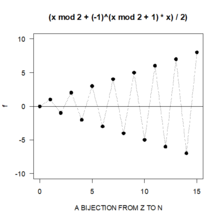Bijection

| Function |
|---|
| x ↦ f (x) |
| History of the function concept |
| Examples of domains and codomains |
| Classes/properties |
| Constructions |
| Generalizations |
A bijection, bijective function, or one-to-one correspondence between two mathematical sets is a function such that each element of the second set (the codomain) is mapped to from exactly one element of the first set (the domain). Equivalently, a bijection is a relation between two sets such that each element of either set is paired with exactly one element of the other set.
A function is bijective if and only if it is invertible; that is, a function is bijective if and only if there is a function the inverse of f, such that each of the two ways for composing the two functions produces an identity function: for each in and for each in
For example, the multiplication by two defines a bijection from the
A function is bijective if and only if it is both
The elementary operation of counting establishes a bijection from some finite set to the first natural numbers (1, 2, 3, ...), up to the number of elements in the counted set. It results that two finite sets have the same number of elements if and only if there exists a bijection between them. More generally, two sets are said to have the same cardinal number if there exists a bijection between them.
A bijective function from a set to itself is also called a permutation,[1] and the set of all permutations of a set forms its symmetric group.
Some bijections with further properties have received specific names, which include
Definition
For a binary relation pairing elements of set X with elements of set Y to be a bijection, four properties must hold:
- each element of X must be paired with at least one element of Y,
- no element of X may be paired with more than one element of Y,
- each element of Y must be paired with at least one element of X, and
- no element of Y may be paired with more than one element of X.
Satisfying properties (1) and (2) means that a pairing is a
Examples
Batting line-up of a baseball or cricket team
Consider the batting line-up of a baseball or cricket team (or any list of all the players of any sports team where every player holds a specific spot in a line-up). The set X will be the players on the team (of size nine in the case of baseball) and the set Y will be the positions in the batting order (1st, 2nd, 3rd, etc.) The "pairing" is given by which player is in what position in this order. Property (1) is satisfied since each player is somewhere in the list. Property (2) is satisfied since no player bats in two (or more) positions in the order. Property (3) says that for each position in the order, there is some player batting in that position and property (4) states that two or more players are never batting in the same position in the list.
Seats and students of a classroom
In a classroom there are a certain number of seats. A bunch of students enter the room and the instructor asks them to be seated. After a quick look around the room, the instructor declares that there is a bijection between the set of students and the set of seats, where each student is paired with the seat they are sitting in. What the instructor observed in order to reach this conclusion was that:
- Every student was in a seat (there was no one standing),
- No student was in more than one seat,
- Every seat had someone sitting there (there were no empty seats), and
- No seat had more than one student in it.
The instructor was able to conclude that there were just as many seats as there were students, without having to count either set.
More mathematical examples

- For any set X, the identity function 1X: X → X, 1X(x) = x is bijective.
- The function f: R → R, f(x) = 2x + 1 is bijective, since for each y there is a unique x = (y − 1)/2 such that f(x) = y. More generally, any linear function over the reals, f: R → R, f(x) = ax + b (where a is non-zero) is a bijection. Each real number y is obtained from (or paired with) the real number x = (y − b)/a.
- The function f: R → (−π/2, π/2), given by f(x) = arctan(x) is bijective, since each real number x is paired with exactly one angle y in the interval (−π/2, π/2) so that tan(y) = x (that is, y = arctan(x)). If the codomain (−π/2, π/2) was made larger to include an integer multiple of π/2, then this function would no longer be onto (surjective), since there is no real number which could be paired with the multiple of π/2 by this arctan function.
- The exponential function, g: R → R, g(x) = ex, is not bijective: for instance, there is no x in R such that g(x) = −1, showing that g is not onto (surjective). However, if the codomain is restricted to the positive real numbers , then g would be bijective; its inverse (see below) is the natural logarithm function ln.
- The function h: R → R+, h(x) = x2 is not bijective: for instance, h(−1) = h(1) = 1, showing that h is not one-to-one (injective). However, if the domain is restricted to , then h would be bijective; its inverse is the positive square root function.
- By Schröder–Bernstein theorem, given any two sets X and Y, and two injective functions f: X → Y and g: Y → X, there exists a bijective function h: X → Y.
Inverses
A bijection f with domain X (indicated by f: X → Y in
Stated in concise mathematical notation, a function f: X → Y is bijective if and only if it satisfies the condition
- for every y in Y there is a unique x in X with y = f(x).
Continuing with the baseball batting line-up example, the function that is being defined takes as input the name of one of the players and outputs the position of that player in the batting order. Since this function is a bijection, it has an inverse function which takes as input a position in the batting order and outputs the player who will be batting in that position.
Composition

The composition of two bijections f: X → Y and g: Y → Z is a bijection, whose inverse is given by is .
Conversely, if the composition of two functions is bijective, it only follows that f is injective and g is surjective.
Cardinality
If X and Y are
Properties
- A function f: R → R is bijective if and only if its graph meets every horizontal and vertical line exactly once.
- If X is a set, then the bijective functions from X to itself, together with the operation of functional composition (∘), form a group, the symmetric group of X, which is denoted variously by S(X), SX, or X! (X factorial).
- Bijections preserve cardinalitiesof sets: for a subset A of the domain with cardinality |A| and subset B of the codomain with cardinality |B|, one has the following equalities:
- |f(A)| = |A| and |f−1(B)| = |B|.
- If X and Y are finite sets with the same cardinality, and f: X → Y, then the following are equivalent:
- f is a bijection.
- f is a surjection.
- f is an injection.
- For a finite set S, there is a bijection between the set of possible total orderings of the elements and the set of bijections from S to S. That is to say, the number of permutationsof elements of S is the same as the number of total orderings of that set—namely, n!.
Category theory
Bijections are precisely the isomorphisms in the category Set of sets and set functions. However, the bijections are not always the isomorphisms for more complex categories. For example, in the category Grp of groups, the morphisms must be homomorphisms since they must preserve the group structure, so the isomorphisms are group isomorphisms which are bijective homomorphisms.
Generalization to partial functions
The notion of one-to-one correspondence generalizes to
Another way of defining the same notion is to say that a partial bijection from A to B is any relation R (which turns out to be a partial function) with the property that R is the graph of a bijection f:A′→B′, where A′ is a subset of A and B′ is a subset of B.[5]
When the partial bijection is on the same set, it is sometimes called a one-to-one partial transformation.[6] An example is the Möbius transformation simply defined on the complex plane, rather than its completion to the extended complex plane.[7]
Gallery
See also
- Ax–Grothendieck theorem
- Bijection, injection and surjection
- Bijective numeration
- Bijective proof
- Category theory
- Multivalued function
Notes
- ^ Hall 1959, p. 3
- ^ There are names associated to properties (1) and (2) as well. A relation which satisfies property (1) is called a total relation and a relation satisfying (2) is a single valued relation.
- ^ "Bijection, Injection, And Surjection | Brilliant Math & Science Wiki". brilliant.org. Retrieved 7 December 2019.
- ISBN 978-1-4704-1493-1.
- ISBN 978-0-521-44179-7.
- ISBN 978-0-8247-9662-4.
- .
References
This topic is a basic concept in set theory and can be found in any text which includes an introduction to set theory. Almost all texts that deal with an introduction to writing proofs will include a section on set theory, so the topic may be found in any of these:
- Hall, Marshall Jr. (1959). The Theory of Groups. MacMillan.
- Wolf (1998). Proof, Logic and Conjecture: A Mathematician's Toolbox. Freeman.
- Sundstrom (2003). Mathematical Reasoning: Writing and Proof. Prentice-Hall.
- Smith; Eggen; St.Andre (2006). A Transition to Advanced Mathematics (6th Ed.). Thomson (Brooks/Cole).
- Schumacher (1996). Chapter Zero: Fundamental Notions of Abstract Mathematics. Addison-Wesley.
- O'Leary (2003). The Structure of Proof: With Logic and Set Theory. Prentice-Hall.
- Morash. Bridge to Abstract Mathematics. Random House.
- Maddox (2002). Mathematical Thinking and Writing. Harcourt/ Academic Press.
- Lay (2001). Analysis with an introduction to proof. Prentice Hall.
- Gilbert; Vanstone (2005). An Introduction to Mathematical Thinking. Pearson Prentice-Hall.
- Fletcher; Patty. Foundations of Higher Mathematics. PWS-Kent.
- Iglewicz; Stoyle. An Introduction to Mathematical Reasoning. MacMillan.
- Devlin, Keith (2004). Sets, Functions, and Logic: An Introduction to Abstract Mathematics. Chapman & Hall/ CRC Press.
- D'Angelo; West (2000). Mathematical Thinking: Problem Solving and Proofs. Prentice Hall.
- ISBN 9780534103200.
- Bond. Introduction to Abstract Mathematics. Brooks/Cole.
- Barnier; Feldman (2000). Introduction to Advanced Mathematics. Prentice Hall.
- Ash. A Primer of Abstract Mathematics. MAA.
























